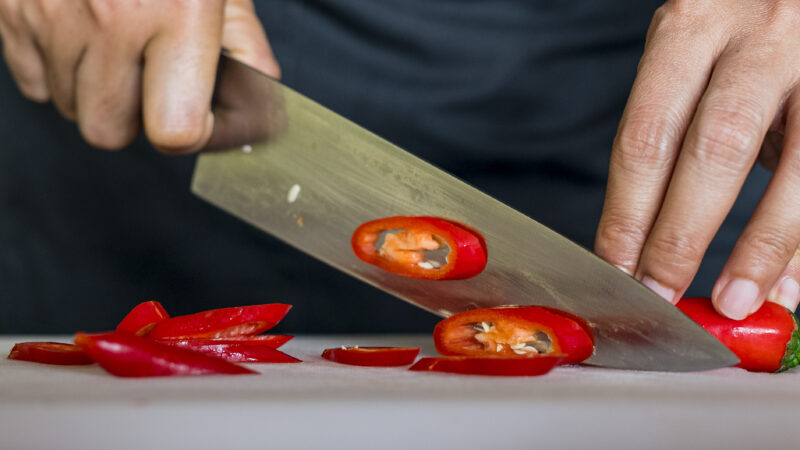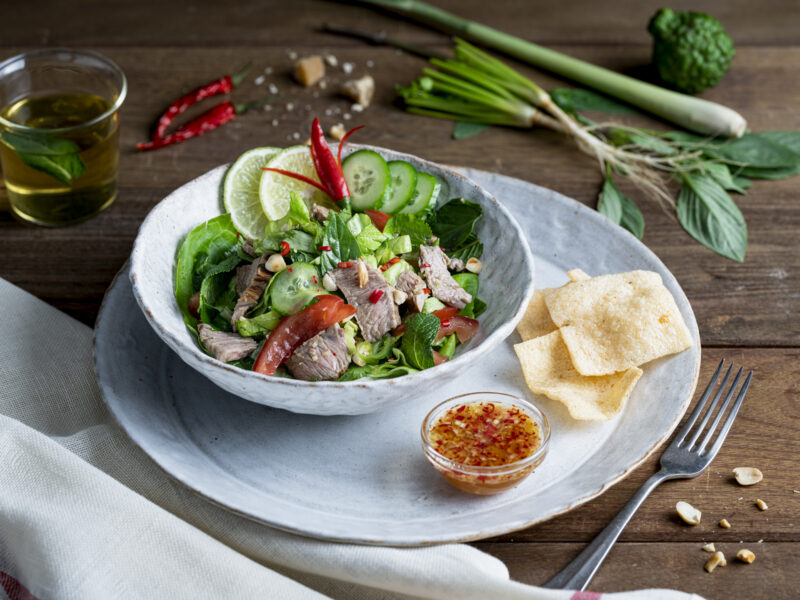The flavors of Thai cuisine
Mysterious, with densely forested mountains in the north, tribes still living in traditional ways, breathtakingly beautiful beaches in the south and a bustling capital: this is Thailand, a country so diverse, so wondrous. Transport yourself to this beautiful country, and bring the amazing flavors of Thai cuisine to your plate.
When I travel, I try to learn as much as possible about the local gastronomy. The ideal way to do that? Get lost in the local markets. It’s a feast for your eyes. Taste street food and discover ingredients you've never seen before. Want to really hit the best stalls and learn all about spices and produce? Then head out with a guide.
Another way to discover a country's cuisine? Take a cooking class! During my stay in exotic Thailand, the hotel's chef invited me for a hands-on experience. The pearly white beach beckoned, but I indulged myself in chili peppers, lemongrass, Thai curries and rice noodles.

Thai cuisine is unforgettable
And I got to experience that firsthand. Thai cuisine is known for its fiery, spicy flavors on the one hand, and a perfect balance between all the flavors on the other. Exotic herbs and spices are masterfully and abundantly used in soups, salads, curries and noodle dishes. Yet the flavors and ingredients vary from one region to another. During a trip through Thailand you will taste so many local dishes, packed with ingredients that nature has to offer.
International influences in Thai dishes
We also owe that rich palette of flavors to cooking influences from Europe, China and India. Thai cuisine knows how to perfectly integrate all these different cooking styles into its own dishes. The result: a unique culinary identity.

International influences in Thai dishes
We also owe that rich palette of flavors to cooking influences from Europe, China and India. Thai cuisine knows how to perfectly integrate all these different cooking styles into its own dishes. The result: a unique culinary identity.

A balance between the 5 flavors
As mentioned above, Thai cuisine always balances the five flavors: salty, sweet, bitter, spicy and sour.
Salt
While in Western cuisine we often season our dishes with sea salt, this is not the case in Thailand. The salty taste in Thai dishes comes from fish sauce, shrimp paste, oyster sauce or soy sauce.
Sour
If you cook Asian food regularly, you undoubtedly have a bottle of rice vinegar in your cupboard. Rice vinegar, as well as lime juice and tamarind paste, provide that fresh sour taste.
Sweet
A typical sweet Thai dish? Pad Thai! In Thailand, they don't use the crystallized form of sugar like we use. There, they work with palm sugar paste. The paste has a deeper, less sweet flavor than its western crystallized counterpart. Be careful if you do add granulated sugar to an authentic Thai dish. The taste can change greatly. I recommend to reduce the quantity of sugar by a third.
Bitter
The bitter taste in Thai cuisine is always of plant origin. You get it from bitter melon or pea eggplant.
Spicy
Finally, the spicy flavor! You get that, of course, from chilies, called prik in Thai. The red peppers are spicier than the green ones. The smaller the pepper, the spicier it is. You also have the dried and ground version of red chilis. A dried chili seed immediately sets your mouth on fire. But the spiciest of all are the bird's eye peppers.
In salads, like the Thai beef salad, or raw dishes use fresh chilies, sliced thinly. I came across the dried chilies mostly in hot regional dishes.

Lemongrass
You'll find lemongrass in almost every Thai dish. It is a white-yellow, hard, fibrous stem with a mild lemon flavor. You use only the pale part in preparations. You can freeze the rest without any problems for later use, for example to flavor a broth. Lemongrass is also good for your health. It seems that tea made from lemongrass could help you with a cold.
Getting started with lemongrass? Then first loosen the fibers with a small meat tenderizer. It will be a lot easier to chop the stalk and it helps to release the aroma.
Tamarind puree
Tamarind paste is an indispensable ingredient in Asian cuisine. The tamarind is a tropical tree native to Africa, and is now found throughout Asia. The fruit looks like long pods filled with seeds that are processed into a paste. The paste has a unique fresh-sour taste.
In Thai cuisine, people use tamarind paste in a variety of ways: in sauces, chutneys, desserts and even drinks. You can find it online and in Asian supermarkets. If need be, you can replace the tamarind with lime juice or a mix of equal amounts of vinegar and sugar.
Cooking with coconut milk
There are many types of coconut milk on the market. Some are loaded with preservatives and emulsifiers, and you really don't want that. The guideline is: the fewer ingredients, the better the coconut milk. At best, the ingredients include coconut milk, water and citric acid only.
In addition, the percentage of coconut is also important. For a creamy curry, you need at least 40% coconut. If you use coconut milk with a lower fat content, then your curry will be more like a soup.
A tip: don't shake the can of coconut milk before you open it. At the top is the coconut cream you need in your curry. Use that solid part first, then add the watery part to thin your curry. You can use coconut milk in this recipe for Thai curry!